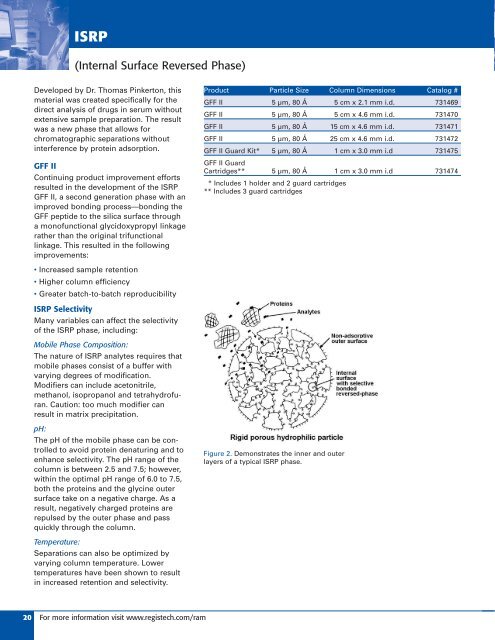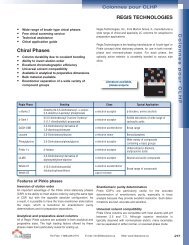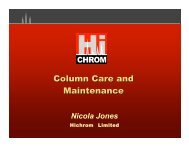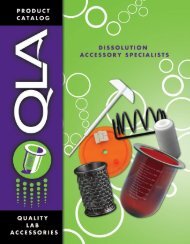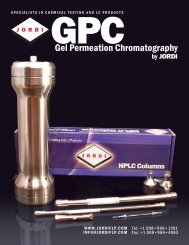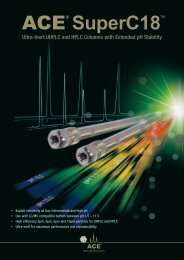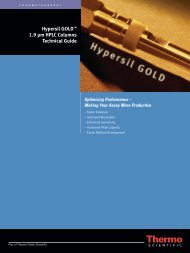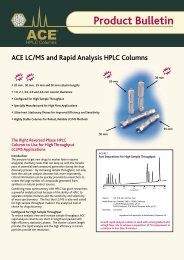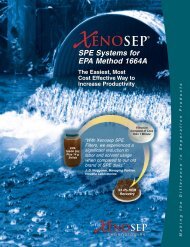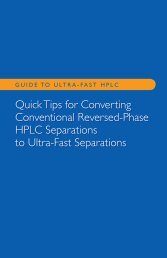Download Entire Catalog - Regis Technologies
Download Entire Catalog - Regis Technologies
Download Entire Catalog - Regis Technologies
You also want an ePaper? Increase the reach of your titles
YUMPU automatically turns print PDFs into web optimized ePapers that Google loves.
ISRP<br />
(Internal Surface Reversed Phase)<br />
Developed by Dr. Thomas Pinkerton, this<br />
material was created specifically for the<br />
direct analysis of drugs in serum without<br />
extensive sample preparation. The result<br />
was a new phase that allows for<br />
chromatographic separations without<br />
interference by protein adsorption.<br />
GFF II<br />
Continuing product improvement efforts<br />
resulted in the development of the ISRP<br />
GFF II, a second generation phase with an<br />
improved bonding process—bonding the<br />
GFF peptide to the silica surface through<br />
a monofunctional glycidoxypropyl linkage<br />
rather than the original trifunctional<br />
linkage. This resulted in the following<br />
improvements:<br />
Product Particle Size Column Dimensions <strong>Catalog</strong> #<br />
GFF II 5 µm, 80 Å 5 cm x 2.1 mm i.d. 731469<br />
GFF II 5 µm, 80 Å 5 cm x 4.6 mm i.d. 731470<br />
GFF II 5 µm, 80 Å 15 cm x 4.6 mm i.d. 731471<br />
GFF II 5 µm, 80 Å 25 cm x 4.6 mm i.d. 731472<br />
GFF II Guard Kit* 5 µm, 80 Å 1 cm x 3.0 mm i.d 731475<br />
GFF II Guard<br />
Cartridges** 5 µm, 80 Å 1 cm x 3.0 mm i.d 731474<br />
* Includes 1 holder and 2 guard cartridges<br />
** Includes 3 guard cartridges<br />
• Increased sample retention<br />
• Higher column efficiency<br />
• Greater batch-to-batch reproducibility<br />
ISRP Selectivity<br />
Many variables can affect the selectivity<br />
of the ISRP phase, including:<br />
Mobile Phase Composition:<br />
The nature of ISRP analytes requires that<br />
mobile phases consist of a buffer with<br />
varying degrees of modification.<br />
Modifiers can include acetonitrile,<br />
methanol, isopropanol and tetrahydrofuran.<br />
Caution: too much modifier can<br />
result in matrix precipitation.<br />
pH:<br />
The pH of the mobile phase can be controlled<br />
to avoid protein denaturing and to<br />
enhance selectivity. The pH range of the<br />
column is between 2.5 and 7.5; however,<br />
within the optimal pH range of 6.0 to 7.5,<br />
both the proteins and the glycine outer<br />
surface take on a negative charge. As a<br />
result, negatively charged proteins are<br />
repulsed by the outer phase and pass<br />
quickly through the column.<br />
Figure 2. Demonstrates the inner and outer<br />
layers of a typical ISRP phase.<br />
Temperature:<br />
Separations can also be optimized by<br />
varying column temperature. Lower<br />
temperatures have been shown to result<br />
in increased retention and selectivity.<br />
20<br />
For more information visit www.registech.com/ram


